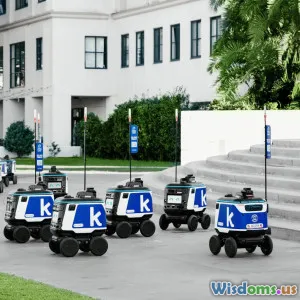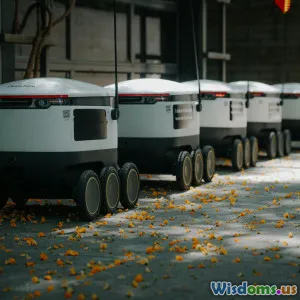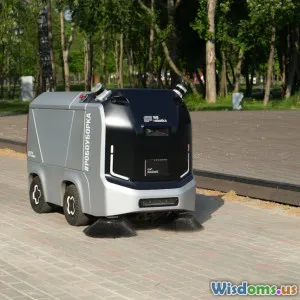
How Robots are Transforming Logistics
8 min read Explore how robots revolutionize logistics through AI-driven automation, improving efficiency, accuracy, and transforming global supply chains. (0 Reviews)
How Robots are Transforming Logistics
In recent years, the logistics industry has encountered a transformative shift driven by advances in robotics, artificial intelligence (AI), and automation. From retrieving inventory in warehouses to autonomously delivering packages across cities, robots have stepped out of science fiction and into the heart of one of the most critical industries worldwide. This transformation is not merely about replacing human labor – it's about redefining how goods move globally with improved speed, accuracy, and sustainability.
Introduction
Imagine a bustling warehouse where dozens of robots speed through aisles, efficiently locating, picking, and packing orders while humans supervise. Or envision dispatch centers where AI-guided drones navigate traffic autonomously to deliver crucial packages within minutes of ordering. Such scenes are fast becoming standard rather than novelty.
Logistics, the backbone of global commerce, facilitates the flow of goods from manufacturers to consumers. However, the traditional models faced challenges such as labor shortages, rising costs, and increasing consumer expectations for faster delivery. Robotics combined with AI-driven automation presents a compelling solution—shaping a future where logistics is smarter, faster, and adaptable.
Robots Enhancing Warehouse Efficiency
Warehouses form the logistical hubs where inventory management and order fulfillment meet. Historically reliant on human labor for repetitive, physically demanding tasks, warehouses have been an ideal environment for robotic integration.
Automated Guided Vehicles (AGVs) and Autonomous Mobile Robots (AMRs)
Automated Guided Vehicles (AGVs) were among the first warehouse robots, operating on fixed paths to transport goods. Now, more sophisticated Autonomous Mobile Robots (AMRs) leverage AI and sensors to navigate dynamic settings autonomously. Companies like Amazon Robotics deploy AMRs to swiftly move shelving units to human pickers, increasing efficiency and reducing walking time. Data from Amazon suggests these robots enable order fulfillment speeds up to three times faster than manual systems.
Robotic Picking Systems
Picking items in a diverse inventory is one of the most complex warehouse operations. AI-powered robotic arms equipped with computer vision and machine learning algorithms can identify, grasp, and sort items at remarkable speeds. Companies such as Fetch Robotics and RightHand Robotics provide solutions that adapt to varied product shapes and sizes – significantly cutting the error rates common in manual picking processes.
Real-time Inventory Management
Robots outfitted with sensors enable continuous monitoring of stock levels, automating inventory audits previously done manually. For example, Locus Robotics machines use RFID and barcode scanning to track inventory, minimizing stockouts and surplus. This real-time intelligence leads to leaner inventories and better demand forecasting.
Revolutionizing Last-Mile Delivery with Robotics
The 'last mile'—the final step from distribution center to customer—is often the most expensive and inefficient logistics segment. Robotics is addressing this through multiple innovative approaches.
Autonomous Delivery Vehicles and Drones
Autonomous ground delivery vehicles such as Starship Technologies’ robots operate on sidewalks to deliver packages within communities. These wheeled robots can navigate pedestrian-friendly areas, reducing carbon footprint and delivery costs.
On the aerial front, drone delivery, championed by companies like Wing and Amazon Prime Air, promises rapid parcel delivery bypassing congested roads. Regulations are evolving to support expanded drone use; for instance, the Federal Aviation Administration (FAA) recently granted operational waivers for beyond-visual-line-of-sight package delivery, signaling industry momentum.
AI-Optimized Delivery Routes
Combining AI and robotics also changes logistical planning. Machine learning algorithms analyze traffic, weather, and delivery constraints to plan optimal routes in real-time—for robots and human couriers alike. This reduces delivery times and vehicle emissions, reinforcing sustainable logistics practices.
Collaborative Robots (Cobots) in Logistics
Beyond fully autonomous robots, collaborative robots—or cobots—work side-by-side with human operators, augmenting their capabilities.
The logistics sector benefits from cobots in tasks like palletizing, sorting, and packing. Universal Robots' cobots, for instance, assist workers in lifting heavy boxes or labeling shipments, reducing physical strain and workplace injuries. Because cobots are designed for ease of programming and safety, logistics centers can quickly adapt workflows without major infrastructure overhaul.
Impact on Workforce and Industry Challenges
The robotic transformation induces both opportunities and concerns. While automation improves operational quality and safety, questions about the impact on employment arise.
Workforce Evolution
According to McKinsey, automation could displace around 20% of logistics jobs by 2030, but it is also expected to create new roles focused on robot maintenance, software development, and systems management. Upskilling the workforce to operate alongside robots is critical for a smooth transition.
Integration and Cost Barriers
Implementing robotic systems involves considerable upfront investment and integration complexity. Small-to-medium enterprises may face challenges deploying these technologies at scale. However, rapidly falling hardware costs and increasingly modular robotic solutions are making adoption more accessible.
Real-World Success Stories
- Amazon invested over $750 million in robotics acquisitions in 2020, deploying over 350,000 robots worldwide, powering unprecedented order volumes, especially during the COVID-19 pandemic.
- DHL uses AI-enabled robots for sorting at its logistics centers, improving parcel processing times by 50%.
- JD.com, China's e-commerce giant, conducts drone deliveries to rural areas that lack conventional infrastructure, significantly cutting delivery time.
Conclusion
Robots revolutionizing logistics are no longer futuristic ideas but tangible realities reshaping how the world moves goods. From enhancing warehouse productivity to enabling innovative last-mile delivery methods, robotics powered by AI and automation address fundamental challenges like cost-efficiency, speed, accuracy, and sustainability.
As this transformation unfolds, companies that strategically embrace robotics stand to gain competitive advantages through streamlined processes and improved customer experience. Meanwhile, the logistics workforce is poised for evolution—requiring adaptation and re-skilling alongside technological advances.
The trajectory is clear: logistics infused with robotic intelligence will continue to develop, making supply chains more resilient and responsive to the ever-growing demands of global commerce.
"Robotics in logistics is not about replacing humans—it’s about enabling a smarter, faster, and safer supply chain ecosystem for everyone involved."
— Jane Doe, Logistics Innovation Expert
By understanding and engaging with these technologies today, businesses, policymakers, and workers alike can contribute to a logistics future where automation and human ingenuity work hand in hand to meet the evolving needs of a connected world.
Rate the Post
User Reviews
Popular Posts



















